design for craft – commitment to kashmir
This post covers Harpreet’s ongoing craft design workshops as part of the Commitment to Kashmir Project 2017-18. The project is supported by the Commitment to Kashmir Trust, Dastkar, Craft Development Institute Srinagar and Titan Company.

Late September rainy day as we depart for the introductory design workshop at Srinagar, Kashmir. The last time I was at Srinagar was 1981. It has been a privilege to be selected as one of the five designers working on this important project. As a designer, I have a special liking for working in the domain of craft objects. For one, it puts me into a different method and style of working than what I am used to. The people producing the objects become a part of the thinking process and I stop deliberating and planning 100% of the process before the objects start taking shape. People, time and place all hold important positions in design for craft, and I find it best to give them that respect. In the more industrial facet of work, whether in print or products, the work may be reproduced in absolute similarity in different factories by different people at different times (re-editions for example). I realise one cannot work that way in craft.


In the first workshop in September, the project team was hosted at this wonderful cottage called Travellers Inn at Rajbagh, Srinagar. A comfortable environment like this one creates those very essential pockets in the mind that actually process and organise information in a richly informative craft terrain like Kashmir.

Also of help is a Josef Albers inspired doormat at the entrance.



The first workshop in September has been very intensive in terms of gathering sufficient knowledge via observation, enquiry and explorations. Papier maché Sakhta is one of the crafts I am working with and of course my introduction begins with this basket of moist processed paper pulp which is being kneaded together (with rice paste glue) for shaping in a die, mould or simply freehand. Sakhta is a word for the dried, hardened papier maché object that shall then be finished, painted and worked upon by the Naqqash. The Naqqash is the fine artist who is responsible for the finished papier maché object. His or her core skills lie in colour, texture end embellishment.
While the process of generating a papier maché object is simple and easy to understand, it is the details that are worth noticing and hearing about. Of course when a craftsman is directly asked or speaks about details, no information is received – not because the artisan is secretive, but often because the artisan filters them out as unworthy of a flowery presentation. Probably like tourist guides who avoid explaining, for example, sewage treatment in old forts and palaces.
A possible way to develop new objects and beneficial opportunities, I realise, is through identifying the overlooked or underdog details in a process (often, one such detail is enough) and expanding that as a design opportunity. It could be a singular part of the process, an ingredient, a raw material, a practice. Easier said, though.


These are most of the tools of the Papier Maché Sakhta maker (upper picture). From left to right, they are used to help shape the object at different stages of hardness. On the extreme left, when it is still wet and not yet put out to dry. In the middle, when it is semi-dry though can still be smoothened. On the right, when it is completely dry. I missed out a wood saw in the last picture.
In the lower picture, rows of papier maché easter eggs drying at the workshop mezzanine.

One of the team decisions has been to consider the papier maché product of Kashmir as a result of two processes – the Sakhta-making and the Naqqashi. The idea is to then develop objects exclusive to each process. While this does not affect the Naqqash (the papier maché surface painter) much, it directly affects the Sakhta artisan, who is not used to developing a finished product in his workshop. However, when viewed in positive light, this is a great growth opportunity for the Sakhta artisan. Provided the design process and objects developed do justice, of course.
My approach has been to work upon the colour of the paper pulp itself as a visual design feature. In the usual work model where the Sakhta maker produces a raw papier maché object for the Naqqash to finish, the colour of the paper pulp does not hold much importance since it is painted upon by the Naqqash. However, given that the Sakhta itself shall now be a finished product, colour, quality and finish suddenly return to focus. It is with this in mind that I chose to experiment with colouring the paper pulp. From trying various additives like fountain pen ink, tea (boiled and unboiled), plaster of paris, cement, turmeric and charcoal (see swatch pictures above) – I have narrowed to turmeric and charcoal. The reasons are easy availability, natural sources, colour contrast between the two and the capability to produce a third colour when mixed.


The upper picture shows turmeric, charcoal and pulp being mixed together. The next picture is the result – a rich olive green pulp ready to be shaped into an object. The result of mixing shall of course vary slightly each time depending on the colour tone of the raw paper used to make the pulp. In this case, the pulp was bluish. Green is a natural result. This is only one of the possibilities.

As a hidden intervention, and one which came about quite accidentally, I realised the benefit of using kitchen cling film onto wooden/terracotta mould before they are dabbed with pulp to take shape. Cling film substitutes newspaper (which is used extensively as a separating layer between the mould and the pulp) and produces neat inner surfaces of objects like boxes, containers and trays. This reduces time and effort required to peel or scrub off the newspaper – which leaves the surface full of scratches. While some may point to the use of plastic, I see no harm in benefiting from its advanced properties, where essential.



My list does not include the copper forming artisans but whoever loses the opportunity to visit the workshops. The government restriction on the usage of machined processes results in a nice hand feel to each object.


Another workshop I am working with is that of a sole entrepreneur, Javaid, who produces bags and accessories for the local Srinagar market utilising the vibrant signature crewel embroidery one can so easily associate to Kashmir. The idea is to help with new designs with which he may approach new markets across the subcontinent, especially in the urban centres of Delhi, Mumbai and Bengaluru.

Javaid drives me to the Khaka workshop, which in simple terms is a tracing repro-shop. In the picture above, note the pinned holes in the tracing sheet. Embroiderers from the locality come to the workshop with their desired print-patterns and fabric. The Khaka workshop repeat prints the tracing onto the fabric by transferring either a black or white solution through the pinned holes onto the fabric. That makes it faster and easier for the embroiderers to mass produce a single pattern. They can of course choose to play around with the thread colours.

Speaking of colours, here is the thread stock at the crewel embroiderer’s workshop. I like his attempt at segregating colours by their visual temperatures.
As an approach to help Javaid, the plan is to introduce him to lesser and subtle uses of colour in embroidery applied onto bags and accessories that are relevant in their look and functionality to India’s urban consumers. I believe the modern craft product user (or collector as is often the case with craft products) of Indian cities is sensitive to two kinds of aesthetic approach. One, where the product retains its strong visual or functional traditional values, often leading to technically elaborate ‘editions’ and the other where it does so yet in a more discreet, affordable and everyday sort of way. It is the latter I am planning to position these new products to.

On one of the evenings, Dr Jyoti Singh, grand-daughter of Hari Singh (the last Maharaja of Kashmir) has been kind enough to invite the team over for high tea at her Almond Villa. I have been told Dr Singh is the founder of the yearly Dara Shikoh Festival of Arts. I gather from our conversation that she is a passionate supporter of the crafts of Kashmir. The Almond Villa is a great location – mountain range rising from the back lawns and a low-tourist segment of Dal Lake up front.

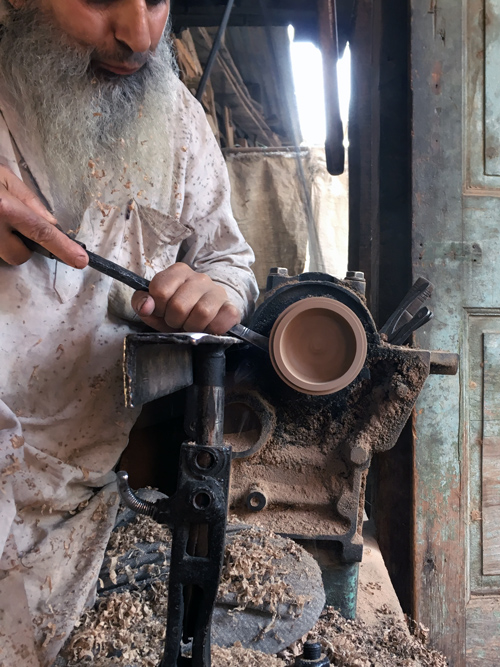
Back to work and another craft – this time the walnut wood carvers of Kashmir. The workshop in the pictures above produces large turned wood bowls and containers from local walnut wood. The carving is outsourced. Sadly in the time between the two workshops of September and December, the wood carver whose work can be seen in the upper picture has passed away. It is as I mentioned earlier, each artisan is a living fragment of the craft. This loss cannot be substituted in any manner.


I also make a visit to a larger wood workshop – one where larger machines and more workers allow for larger pieces to be produced quickly. This is craft too. The definitions shall always be blurry.
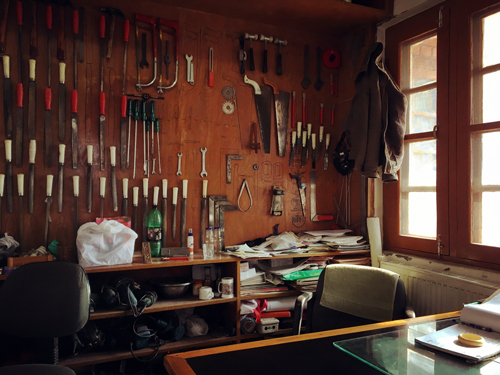
The local Craft Development Institute (CDI) is an important meeting point for several of these artisans to converge – for workshops, talks and even demonstrations. This is the room of the workshop head, Akhtar.

On one of the searches for an alternative wood turner, we encounter this locked workshop. Practically everything the man needs to communicate about his business is on this door. It could be his business card, this picture.


I find doors fascinating. The one in the upper picture is a washroom door at one of the wood turning workshops. The picture immediately above shows off Pinjrakari, the traditional wood lattice work of Kashmir, older versions of which can still be spotted while walking around the streets of old Srinagar. Khatamband is the other variation, though I believe the term is used for ceiling applications.

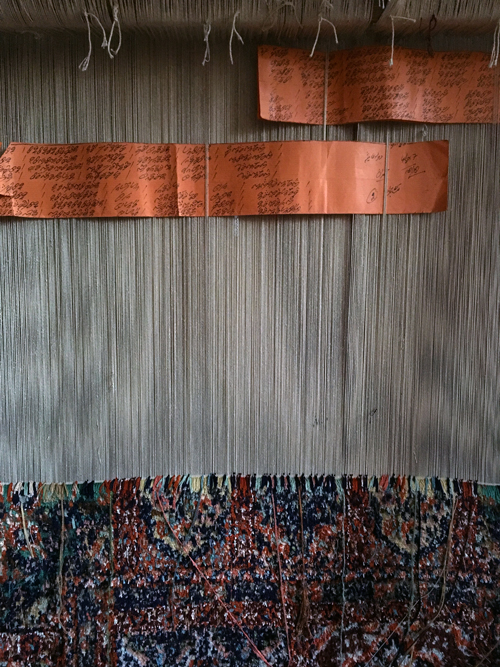

Meanwhile I also sneak into the textile workshops to have a look at whats happening there. New terms and methods find their way into my vocabulary. Often, I am seeing what I have only heard of before. These pictures (above) are from a Kani shawl maker and a carpet weaver’s workshop. As I have learnt from designer Chandrashekhar Bheda who is a textile design mentor in the project, the copper coloured paper sheets in the middle picture (above) are the weaving instruction code for this specific carpet design. The codes are commonly called the ‘Taleem’. I think it also means education. That does make sense.

These spools of coloured thread are from a Sozni and Aari embroidery workshop a short drive away from Srinagar. As a designer I see tints, shades, luminosity and Pantone numbers. It is so difficult to unsee or unlearn these things that I wonder how an embroiderer experiences colour. In that sense, the designer and artisan are never on the same plane.

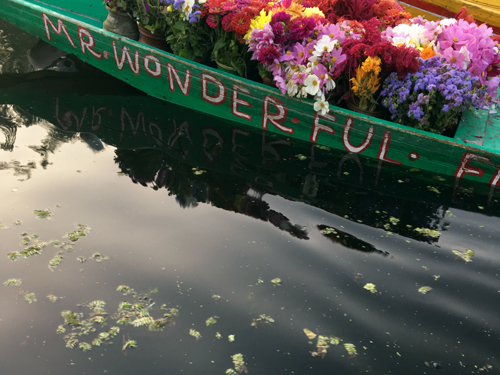

In the September workshop, I was fortunate to be in the company of designer Devika Krishnan, who made a phone call to a friend in Srinagar and arranged a tour of the floating vegetable and flower market on the Dal lake. At 5am we were off in Shikaras (the signature touring boats of Srinagar) to the market (upper picture).

This was followed by a long boat-ride over the Dal to Nigeen Lake where we met the host for this special morning, Yaseen Tuman, who also treated the team to a wonderful breakfast on his houseboat ‘Mascot No.1’. Note the Khatamband ceiling in the picture above.


If all the pictures seem summery and comfortable, the trip In December was not. Though this second workshop was shorter, it was sufficiently long enough to experience the cold, the power cuts and a general December gloom over the city. Work goes on though, and the benefits of a Kangri (the portable hot-coals-in-a-basket solution – see picture above) are immense.
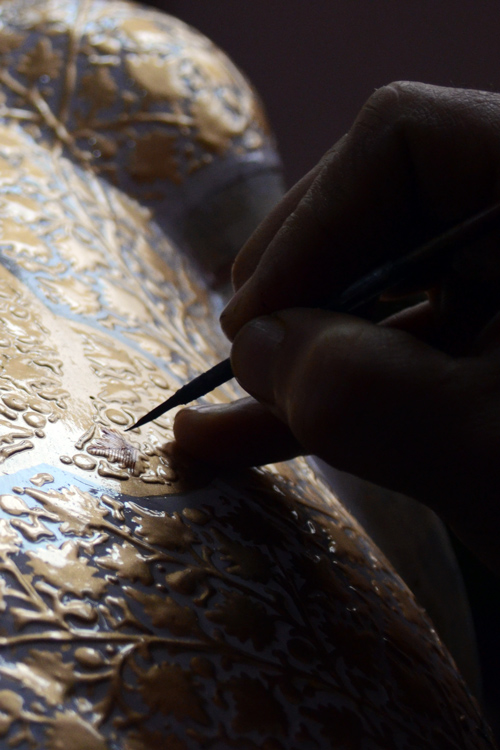

I did finally manage to spend a good amount of time with Iqbal, the Naqqash – the fourth and final craftsperson assigned to me. Since he has already demonstrated his skills with some of my explorations in the September workshop, I am a bit clearer on the opportunities his work presents. In the blue box picture above is one of the effects I aim to expand upon – a technique by which the design pattern is raised. I shall only be providing him with about 60% of the instructions though. The rest will come from him. A contribution that I value greatly in the design of craft objects.

Nearing the end of the second workshop, I realise how little time we have had for visiting popular sites like this wooden architectural wonder of a mosque – The Shah-e-Hamadan. The interiors are donned in extensive papier maché. From a designer’s perspective, it seems disastrous to have a wooden construction of this scale with inflammable interiors too. The repair visible on the topmost portion is damage control after a recent lightning strike. But its over 500 years old. Thats a lot of time. And somewhere we’re so tied to the idea of permanence.
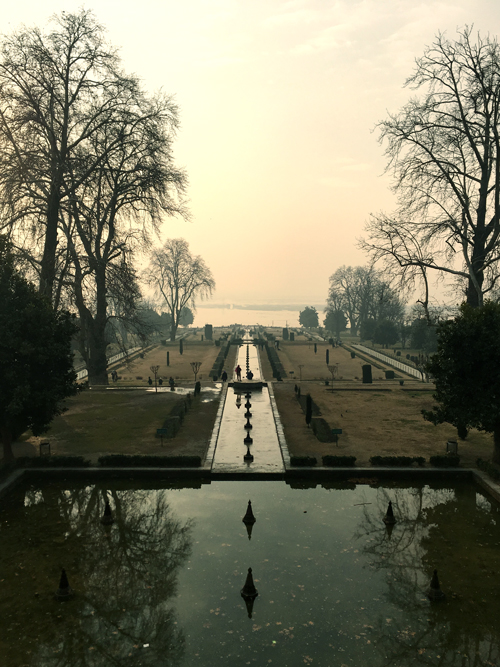

The December workshop is wrapped up with a trip to the Nishat Gardens. I’m told its a better place to see in spring. Of course, but this will do as well. Outside next to the Dal, a boatman brings in his boat as the sun sets.

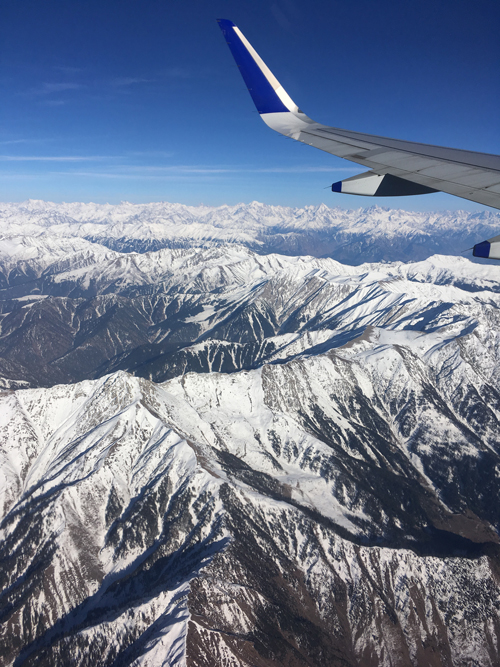
As an interesting coincidence, I happened to shoot the same portion of the mountain range on both my trips to Srinagar. The first one is in the first week of October, the second is Christmas day.
Hopefully, the next one shall be March.
Thanks to the following for their continued support: Shruti Mittal and Riya Gupta: Commitment to Kashmir / Laila Tyabji, Dastkar / Jatin Bhatt, Pro V-C, AUD / Chandrashekhar Bheda, Textile Designer / Tauseef Rehan Abidi, Studio Saswata, who has been great company at the December workshop / Yasir Mir, CDI / Burhan Khateeb, Industrial Designer / Midhun KM, Industrial Designer / Devika Krishnan, Designer / Gunjan Jain, Textile Designer / Akhtar, CDI.
If you’re a designer interested in participating in the Commitment to Kashmir Design Workshops, please write in to ctok.delhi@gmail.com expressing your interest. All photographs ©Harpreet Padam 2018q
Thank you for this wonderful journey through the description and the Photographs …Specially about papier maché technique and the process …can you Kindly elaborate a little on as to how the raised effect is achieved by the naqqash while painting a papier maché Item…..
This is really really amazing and photographs captured with such details.